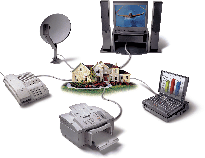|
The wiring infrastructure in most homes has
not changed in 50 years and is unable to fully support the technologies that are
available to consumers today. However, today's wiring systems are created
to handle today's technologies and provide the electronic foundation for a
"connected home." This advanced infrastructure called structured wiring is
necessary to ensure that your family can be connected to today's services and
prepared for new technologies.

Structured Wiring vs. Conventional Wiring
Think of wiring as an informational pipeline.
Conventional wiring has the data capacity of a squirt gun. By comparison,
structured wiring has the capacity of a fire hose and can transmit more
information faster. Conventional wiring, which is found in most homes, is
adequate for basic voice, fax or data communications. Structured wiring is
more advanced wiring. Not only can it handle traditional telephone, fax
and data communications, but also sophisticated video and data signals from
computers.
Components of a Home Wiring System
An advanced home wiring system is usually comprised of
three main components:
-
The Service Center
The service center is the part where all outside services enter the home,
including cable TV, telephone, DSS satellite, Internet, etc. This central
hub distributes these services to locations throughout the house in a way
similar to how the electrical breaker panel controls electricity flow.
|
-
High-Performance Cables
Certain services like digital satellite, high-speed Internet, and digital
TV require high performance cables to allow full access throughout the
home. Most systems include RG-6 coaxial cable for TV and video, and
Category 5 or better twisted-pair cable for telephone and data. Coaxial
cable provides maximum protection from interference with your TV picture.
Category 5 or better cable provides high-speed access to multiple phone
lines without cross-talk. These cables deliver all the performance you
need today, while providing the capacity to handle tomorrow's
technologies.
|
-
Multi-Use Outlets
The outlets in each room determine which services are available in that
room. Each outlet can be customized to a consumer's specific needs based
on which services are desired in each room (cable, Internet access,
telephone, etc.). Without the proper outlets, the high-performance wiring
behind the wall is of little value.
|
Investment
Regardless of size, location, or cost of a home,
incorporating minimum wiring standards can add value to the home at resale.
A "connected home" can be achieved today with minimal investment and is not
limited to custom construction. The initial investment varies depending on
the scope of an installation, with a range of upgrade and home control options
available to consumers who want maximum control. In addition, to ensure
that your home is "future-proofed" and your investment is secured, it is
recommended that a 2" PVC pipe be installed from the basement to the attic. This
will enable new wires to be pulled, if ever necessary, between floors without
having to replace walls or ceilings.
Resale Value
Homes built today without an upgraded wiring system
will not be able to accommodate the demands of new technologies. They will not
retain value as strongly as those built with a solid technological
infrastructure and, in fact, may not even be considered by a large percentage of
future homebuyers. With the rapid growth of new technologies for the home, the
ever-changing working environment (telecommuting, home business, etc.), and the
revolution in home education and entertainment opportunities, it is predicted
that installing structured wiring will potentially increase the resale value of
a home.
Return to Rhyne Built-in Amenities
|